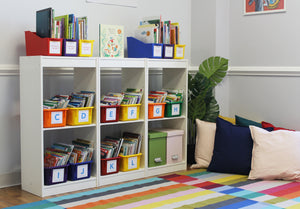How to lend books safely during the Coronavirus
We all want our students to return home with books, but how do we let students borrow books in the age of the coronavirus? I put together a guide on how to sanitize your classroom library. You’ll be relieved to know that it does not mean sanitizing each individual book! Phew!
Bringing home books from school connects our students back to their learning environment, back to the expectations you set in class, and back to the reading strategies you have taught. Physical books are a reminder of what school feels like, smells like and looks like. Books can be a social emotional bond that reduces anxiety.
Reading on paper appeals to all senses, and at this time, when kids are being presented with so much screen time for both leisure and learning, we need to find ways to connect them to real objects, away from screens. Too much screen time can lead to obesity, irregular sleep schedules and shorter duration of sleep, behavioral problems, loss of social skills, violence and less time for physical play.
Don’t get me wrong: ebooks have a place in our family too. We use audio ebooks to listen to new stories being read with voices from other narrators, not just Mommy. It’s awesome to become familiar with a variety of pacing, intonation and accents of course. My daughter likes for me to read each page, and then she presses the button to hear how the narrator reads it.
Having said that, our daughter dives into a physical book in ways she doesn’t apply to the screen. She examines every illustration closely, takes her time to turn the pages with care, scrunches her face up as she thinks deeply about the book. The daughter of a teacher and bookseller, she has dozens and dozens of books in her collection. Many of the communities I serve do not have that luxury.
Let’s get these books into the hands of our little ones! Research shows that reading on paper is more effective than reading on an electronic device. Teachers know that reading isn’t just about reading extensively or decoding. It means deepening reading comprehension, inferring, thinking critically about what an author is saying, reflecting on how this new information connects to schema. In a Norwegian study, researchers found that when asked to read the same passage from a paper text or an electronic device, readers who read from a paper text remembered the sequence of events with more accuracy.
People, especially young readers, love to display what they have read. Print books are a physical reminder of our intellectual journeys. We get a sense of accomplishment from turning the pages and seeing a bookmark make its way through a chapter book, or from a pile of leveled books that have been read grow taller. Adults buy larger and larger bookshelves to hold the quantities of books we read. Meanwhile, little ones love showing off how they have already read all of the titles from Captain Underpants, Harry Potter, Ivy and Bean…
Let’s get our students borrowing our books safely! Notice that I say “borrow,” not “shop.” I love having students shop for books. I do, but letting multiple hands touch books is ripe for creating fomites, objects that transfer infection. So, here are a few tips to help your students borrow books safely from your classroom library.
1. Create small stacks of books to borrow
Make small stacks of books that match your class’ reading levels. Lay out the books on one or more sanitized tables away from students, such as your guided reading area or the writing center. If you have the materials, I recommend 5-10 books for A through E readers, 4 books for F through H readers, 3 for I through L, and 2 for M and above. Each child will get to borrow all of the books in one stack, and they will return them a week later.

2. Map out physical spacing
Place a round shape or a footprint shape on the floor to indicate where students will stand to pick up books from your table. Then, place another shape six feet away, and another six feet further. If your classroom allows it, have two or more places where students can line up to borrow books. If you are creating physical spacing, then make each station a set range of levels. For instance, the blue station is for levels C through E, and the yellow station is for F through H.

3. List students’ names
List which students you will call to each station. I recommend grouping them by level so you can display all of the stacks at that level at once, and then display the next few stacks at another level.
4. Prepare a poster for your procedural mini-lesson
I suggest a poster that shows six steps.
I pick a stack by:
- standing on the dot.
- waiting for a friend to move away.
- using hand sanitizer.
- using my eyes to choose, not my hands
- saying: “Your turn to pick a stack.”
- bring all of the books back to my table.
Below is an example of this poster.

5. Teach students how to wait their turn
We teach new procedures to our students all of the time. In fact, we remind them of procedures every time they come back from break. This is just a new procedure. Here’s a minilesson to teach your students to wait their turn at a safe distance. Per CDC recommendations, make sure to teach this lesson with a mask and gloves.
Sources:
Books vs. e-books: The science behind the best way to read
Drop That Kindle! 10 Reasons Print Books Are Better Than E-Books
Physical books still outsell e-books - and here's why





Comments
Leave a comment